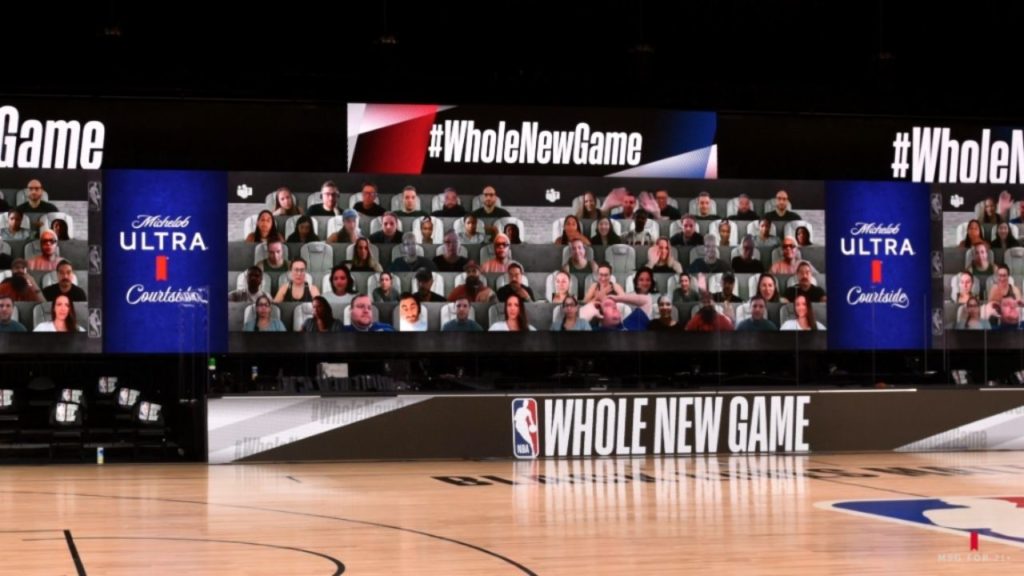
Until now, sports games were simply cancelled if no live audience could be there. Without the shouting, cheering, chanting, and hype generated by an audience, games can feel empty & emotionless.
Due to the pandemic, massive sports franchises like the NBA have had to innovate new ways to maintain audience engagement and simulate traditional playing conditions (i.e. with a live audience) despite not having a single body in the stands.
How have they done this, and what is their plan moving forward?
We found out thanks to a recent InnovationX Roundtable discussion on ‘Fan Engagement and the Future of Entertainment’ in the NBA. The conversation was moderated by SCET program development fellow Mike Grandinetti. Alongside Mike, a variety of experts in this area — Brendan Donahue (NBA 2k League Commissioner), Jacob Fein (NBA Global Partnerships Manager) and Michael Proman (Scrum Ventures Managing Director) — discussed how the NBA maintained a vision for creating deep fan engagement across all communities even without a physical presence.
Grandinetti started off the discussion with a reflection on a the vast technological changes seen in only a few decades. “As a kid growing up, we had baseball cards & Chuck Taylor converse. It was pretty basic stuff… Nowadays, I am blown away by some of the remarkably disruptive technology being used in NBA & the world of sports.”
Many recent innovations are thanks to the Team Marketing Business and Operations (TMBO) group, a segment of the NBA that has recently been focused on engaging the NBA fanbase on a digital basis specifically through retail-centric partnerships.
TMBO started 25 years ago as an effort centered around innovation. “NBA teams quickly bought into the notion that, while they competed on the court, they were better off working & learning from each other off the court,” said Donahue.
TMBO’s 40-person group focuses on bringing together data on all the teams & overall performance related to sponsorship, ticket sales, etc. Seeing the current environment with Covid-19, TMBO shifted their attention towards developing their esports presence after seeing entire arenas being bought out for League of Legends matches. The team used their immensely popular game NBA 2k as a vehicle to enter the space of esports.
“Who knew that Covid would have been the mother of a ton of innovation,” remarked Donahue as he reflected on the developments since the pandemic began.
As matches that were played in the NBA’s New York eSports studio had to be transitioned to remote operations, TMBO quickly pivoted to a version of the game that could be played remotely. They created a broadcast studio that was entirely virtual, allowing partners from all over the world to enter that space. And now from these developments, the NBA has a completely remote virtual studio which will allow them to host games in Europe, China, or really wherever they want. By keeping an eye on the horizon, the NBA has secured a spot in remote gaming that serve them well in the future.
Michael Proman hammered home the significance of this point with some staggering numbers. Epic Games currently has a $17.3 billion valuation. Draft Kings is $12 billion, LiveNation is $10 billion, and Manchester United is just $2.5 billion. “No one would have guessed these valuations in the past.”
As the conversation veered towards fan engagement, the NBA’s recent partnership with Microsoft came to light.
After officially partnering with the NBA, Microsoft teams has introduced a “together mode” feature wherein fans can be seen on massive 17-foot screens surrounding the basketball court.

“The Microsoft virtual fan experience allows us to bring our fans closer to the NBA brand & family. And the reality is that the majority of our fans will never be able to attend a physical game in person. So being able to simulate this experience was a huge leap forward. Not only are the teams able to leverage the screens but our parters as well,” remarked Jacob Fein.
This theme of fan engagement was at the heart of the hour-long roundtable. A few important takeaways from this point:
- Virtual reality is already being utilized to enhance the fan experience. NBA fans can currently tune into games via a VR headset, allowing people to feel as if they are in the stands watching the players live. Companies like 4D Sight are bringing advertising & commercialization to virtual reality, which can be the source of a huge spurt of growth.
- Esports are continuing to see massive growth & the NBA is determined to keep a strong foot in this space. “We’ve been running a league for 70+ years but we’re learning a ton right now from the world of esports. I’m watching what Overwatch & League of Legends are doing just as much as I’m watching anything else,” said Donahue.
- Direct-to-consumer (DTC) experiences are of increasing interest to the NBA as mobile content drives more and more attention each year. Over the next 5 years, the NBA plans to embed the commercial experience into virtual content, using real-time viewer feedback (like Twitch live chats) to inform how they NBA develop their broadcasting.
The discussion has profound implications regarding the future of entertainment. Other industries facing similar circumstances should take note culture of innovation that has been fostered within the NBA.
And for all you die-hard NBA fans, rest assured that the NBA will be constantly finding new ways to promote engagement & participation in newer, more advanced audience experiences.
